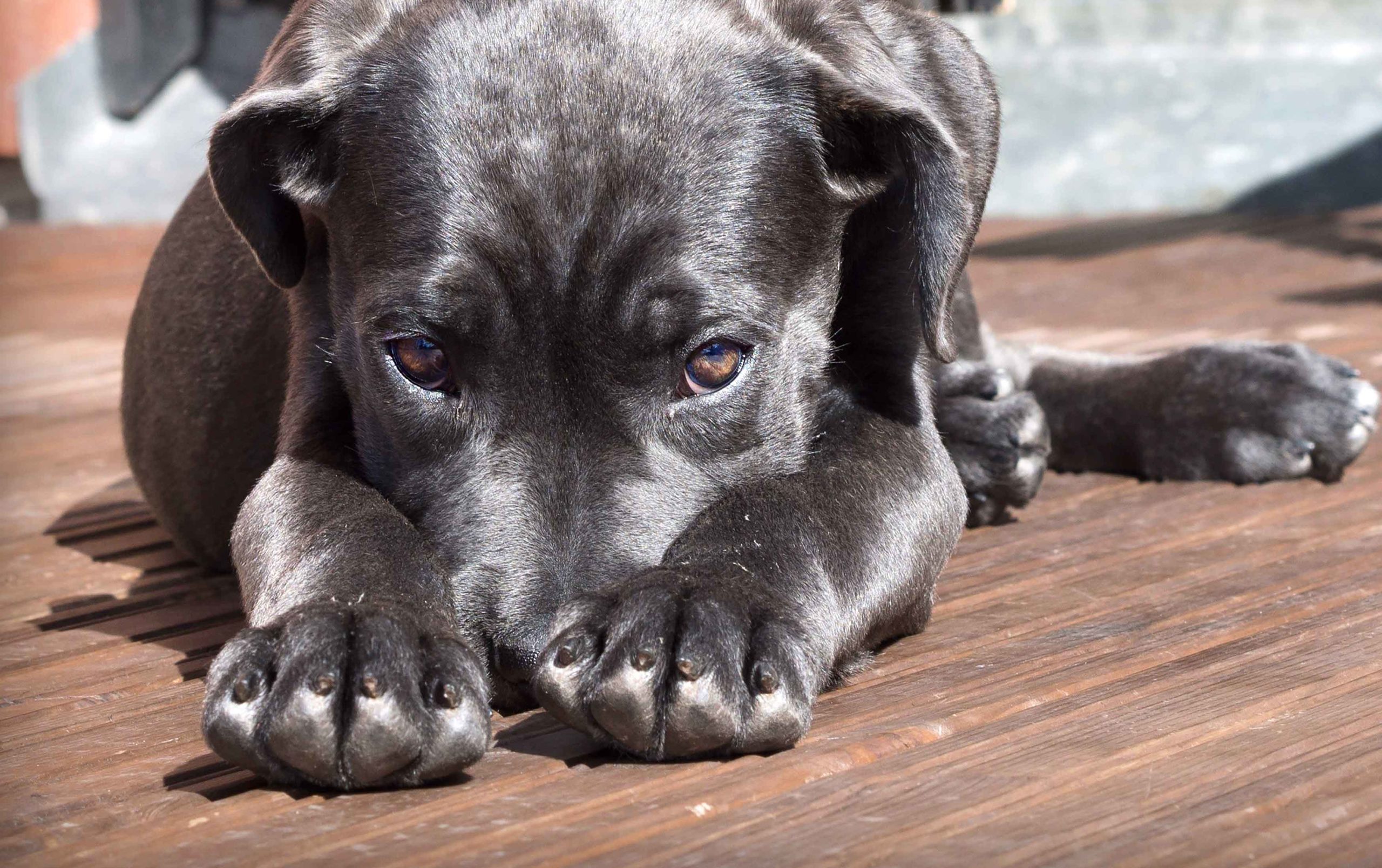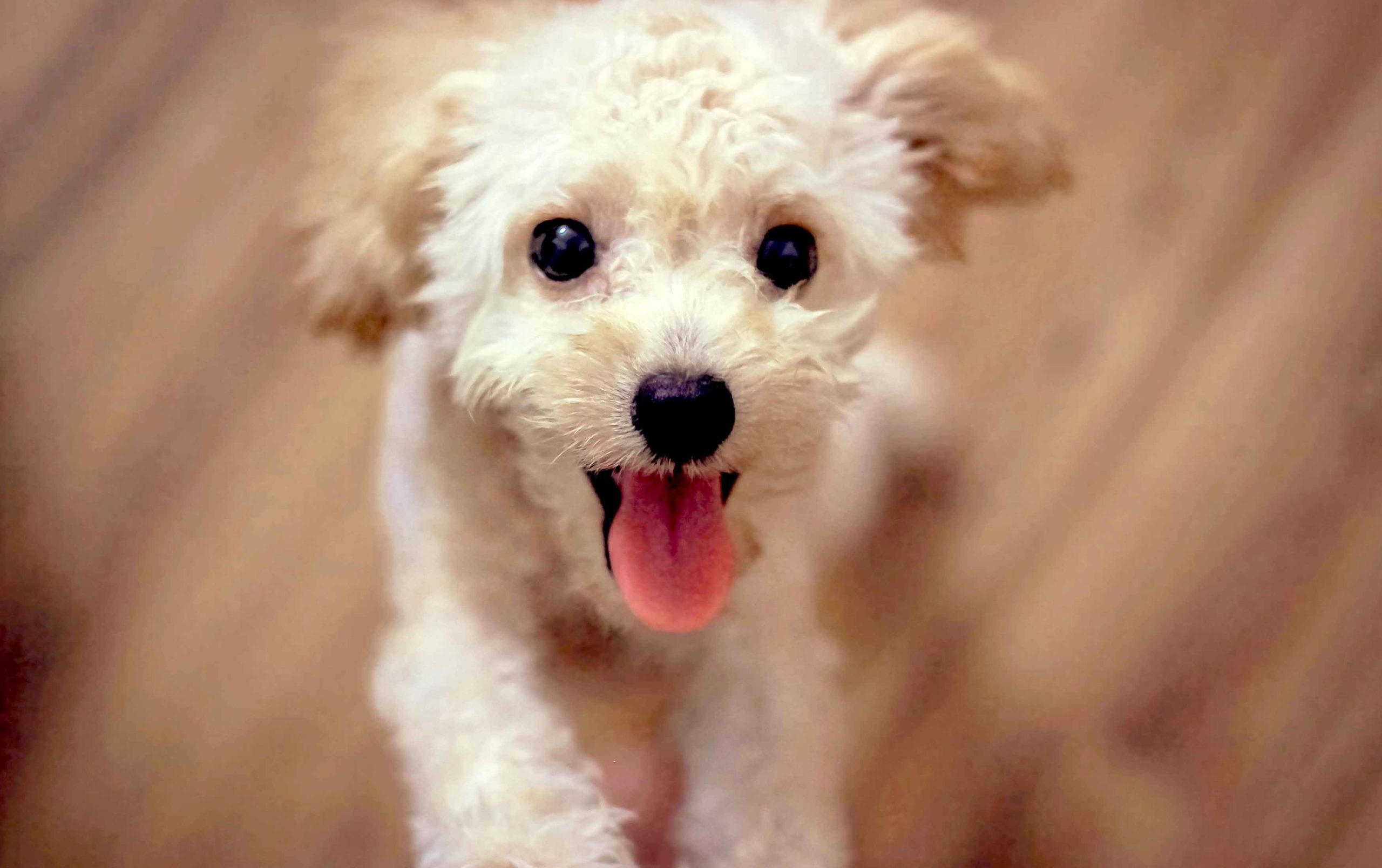Well, yes, you could say that dog calming signals are kind of like the bat signal.
Calming signals are your dog’s way of communicating they are uncomfortable, stressed, or excited and like Batman, we need to look for these signs so we can answer their call appropriately.
Since dogs respond to feedback given through sight, sound, and touch, it only makes sense that calming signals are a set of body language skills that use these senses. These actions help build and maintain healthy relationships, relieve stress, convey good will, and eliminate tension, all to make their feelings and intentions clear in order to avoid volatile situations.
Ultimately, it is good that your dog utilizes calming signals and they should NOT be punished for displaying them.
Much of what we know about calming signals comes from the work of Turid Rugaas, a Norwegian canine ethologist. Through her research, we have learned the importance of dogs learning to display signals, either initially or in response to others, in order to avoid confrontation. In turn, the other party hopefully recognizes the signal(s) and alters their behavior accordingly.
Though all breeds display calming signals, and many such signs, like panting or stretching, come naturally to most dogs, some signs are more obvious and/or developed in others in part due to physical differences. For instance, dogs with cropped tails or ears aren’t able to communicate as clearly, if at all, with these body parts like those with un-cropped tails/ears. And have you ever seen a small dog or puppy yawn when being picked up? This is possibly a calming behavior because, well, wouldn’t you be stressed if you were lifted so high off the ground?

How Can You Relate To Dog Calming Signals
It might help you to relate to your dog’s calming signals if you think about how it would feel to return to rollerblading 30 years after you last laced up.
Even before putting on your blades, you might be a little anxious. Your palms may sweat a bit and your heart rate would increase. Your excitement doesn’t escalate into fear, and once all your equipment you’re ready to hit the trail.
Your knees are slightly bent and you’re gliding through each stride. You can only go straight forward though and aren’t able to control your speed very well.
You’re politely asking people to move over and at times using a bell, but you start to get nervous when you see there’s both a small downhill and a group of people on motorized scooters ahead. You try to brake but it’s not helping. They are getting closer. “Bbbring-bbring”. They don’t budge. “Excuse me”, you shout. Nothing. “Hello, please move!” They aren’t paying attention to you so you have to ditch onto the concrete. Ouch!
Cautionary Tale
Just like remembering how to rollerblade (at least for the most part in my example above 😜), dogs will always have the knowledge of canine calming behaviors.
However, if dogs are punished for displaying calming signals or unable to practice them, then they may resort to other, more aggressive behaviors when put in a stressful situation to make their feelings more evident.
I mean, since your clear vocalizations and gestures weren’t acknowledged by the group on their scooters, the next time you go rollerblading, you might be tempted to push right past them, causing them to fall and thus leading to an avoidable confrontation. Not good!
So What Are Dog Calming Signals?
Here is a list of the most common calming signals. When deciding if a dog is exhibiting calming signals or not, always consider the context of the situation surrounding the behavior.
Blinking/Softening gaze
Head-turning/Averting gaze
Play bow
Freezing
Pacing
Curving
Leaning/Clinging (To humans)
Sitting/Laying down
Hyperactivity/Frantic behavior
No, your dog is not always ignoring you or blowing you off
Marking
Licking (Nose, lip, coat, genitals, etc)
Tail wagging
Yawning
Sniffing (Ground, etc)
Splitting
Panting
Stretching
Whining or barking
Slow and/or stiff movements (Legs, body, and/or tail)
When Do Dogs Give & Possibly Stop Giving Calming Signals?
It’s common to see dogs use calming signals in the following situations:
Getting a hug
Feeling trapped
People are yelling (either at each other or at them)
Someone bending over them
Direct eye contact
Confused
Someone approaching them directly from the front
Someone coming too close to their face (with or without physical contact)
Anticipatory excitement (about to go for a walk)
Asked to do something they don’t want or like to do
When meeting another dog (for the first time)
Ideal Signals from Approaching Dog:
• Curving
• Not approaching head-on
Possible Signals from the Dog Being Approached:
These would be given in an attempt to slow down the approaching dog if there is concern about their speed, angle, etc.
• Sniffing the ground
• Turning their head, gaze or entire body
During play
If play is getting too rough, a dog might stop and sit to convey they are stressed. Other dogs might come over to split (creating space between two dogs, people, etc)*.
*Has your dog ever tried to do this when you hugged someone? They aren’t jealous, they are trying to prevent what they feel might lead to a confrontation.
When engaging with other species (humans, cats, etc)
Possible Signals:
• Play bow
• Looking away
Movements of others, even subtle ones like leaning forward or larger ones like hugging (whether it’s hugging the dog or another person)
Possible Signals:
• Splitting
• Looking away
Visiting the vet
Possible Signals:
• Nose licking
• Yawning
• Full body shimmy (like when wet after a bath)
When Do Dogs Stop Giving Calming Signals?
Dogs STOP using calming signals if they were:
Punished for displaying signals in the past
Attacked when using them in the past
Pulling on leash when they are giving signals to another dog
Too stressed
Wait, Dogs Can Feel Stressed?
Yes! Just like us, they can feel stress in a variety of situations like when in a new environment, hearing a strange noise, or encountering a change to their daily routine.
We have our own methods to reduce stress (taking a bath, doing chores, going on a walk, talking to a friend), and the same is true for our canine companions. The only trouble is they can’t tell us with words, but they do tell us with these often subtle signs, and sometimes those are hidden in typical canine behavior, like running around with the zoomies.
Signs of Stress
Dogs STOP using calming signals if they were:
Hiding, avoidance, or escape behavior
Changes in eyes and ears (pupils dilated, whale eye, ears pulled back, furrowed brow)
Panting
Drooling
Vocalizing (whining, growling, or barking)
Shedding/Dandruff
Scratching/Licking/Biting self
Chattering Teeth
Sweaty paws/Increased urination
Diarrhea/Urinating or defecating inappropriately (providing house trained)
Circling/Restless/Pacing
Shaking
Chewing items
Refusal of food/Decreased appetite
Allergies
Displacement behaviors/Increased reactivity
Shuts down
Increased sleeping
How To Recognize Your Dog’s Stress
In order to differentiate stress signs from normal behavior, you must be familiar with your dog’s regular demeanor. Then you can tell if they’re licking their lips because they’re anxious or because they want a treat*! Or yawning because are overwhelmed or simply tired.
When relaxed, your dog will have semi-erect or forward-facing ears, a soft mouth, and round eyes. They will distribute their weight evenly on all four paws. Distinguishing normal behavior from stress signs will help you quickly and effectively diffuse an uncomfortable situation.
*Dogs typically don’t have interest in even high-value treats if they are stressed.
How To Respond Your Dog’s Stress

If your dog is stressed, first remove them from the stressor
Find a quiet place for your dog to regroup. Resist the urge to overly comfort them. This will only confirm that their fears are justified and may make them less confident in the future.
If you want to pamper them with petting or treats, make them earn them first by performing a routine activity, i.e. sitting. Responding to known commands will distract them and provide a sense of normalcy. It’s amazing how comforting sit and down can be to a worried dog.
Need help addressing your dog’s fears? Contact me so we can start talking about a treatment plan.

If your dog becomes consistently stressed, see your veterinarian
Your veterinarian can determine if there is a medical issue contributing to your dog’s behavior. After giving your dog a clean bill of health, they may suggest you (continue to) work with a dog trainer to address your dog’s fears.
As with humans, exercise can be a great stress reducer. Unless otherwise advised, physical activities like walking or playing fetch help both you and your dog release tension. It’s also good to provide your dog with a safe place in your home where they can escape stressful situations. Everybody enjoys a calm place to retreat.

And, finally, remember that stress isn’t always bad
Fear is a stress-related emotion that prompts us to avoid potentially dangerous situations. So, stress may actually be a protector. Regardless, stress is part of everyday life for us and our dogs, so we should learn how best to deal with it.
Other Tips For Calming Signals
At the first sign of calming signals, modify your behavior. For example, when approaching a dog, do so in a curved fashion if at all possible. This allows for your initial greeting to be polite in nature.
When training, if your dog is exhibiting calming signals, consider ending the session if you can’t determine and make the appropriate adjustments to reduce/remove whatever is stressful to your dog.
Splitting can be used during classes and playtimes if you feel your dog is getting too rowdy or you are concerned about a potential conflict. In order to show goodwill, one of the signals you should use the most frequently and one of the easiest to use is a head turn followed by turning sideways to your/a dog if need be.
Some signals, of course, are easier for humans to imitate than others, such as averting eyes, turning, yawning and splitting.
Your Body Language
The most important thing that you can do when working with your dog is to simply watch them. Humans have a very different communication system from dogs and many things that we do our canine companions find offensive and distressful.
When our pets show us calming signals, we need to respect these and cease what we are doing.
All dogs are individuals and some will be more sensitive than others to particular situations. Some of the more predictable human behaviors that elicit calming signals are raised voices (I hope that one is obvious), leaning over a dog, staring, patting a dog on the head, and physically manipulating a dog’s body position.
While dogs can be taught to tolerate some of these actions and even occasionally come to like them, this does not come naturally for them so they’ll display subtle signs. Sometimes these signs are hidden in typical canine behavior, like running around with the zoomies.
Dog Calming Signals Takeaways
Give your dog the opportunity to learn and use their signals (many come naturally but it is great for them to both display and observe signals to/from other dogs as well).
Give yourself the opportunity to listen and respond to your dog’s calming signals with compassion — Your dog may be stressed and shouldn’t be punished for it.
RESOURCES
Rugaas, Turid. On Talking Terms with Dogs: Calming Signals. Dogwise Publishing, Washington. 2006.
Rugaas, Turid. Calming Signals: What Your Dog Tells You. Dogwise Publishing. (DVD run time 48 minutes).
Calming Signals Community – http://www.canis.no/rugaas/index.php
Start My Free 21 Day Training Crash Course
Over the next three weeks, you’ll get helpful dog training tips and tutorials, fun canine and human fitness training exercises, and a collection of other healthy living guides right to your inbox 😉.
You’ll also receive additional dog and fitness training pointers, cute and inspirational stories, and my in-person and online class and pack walk schedule through my regular Fun Feet Pawblication©.
